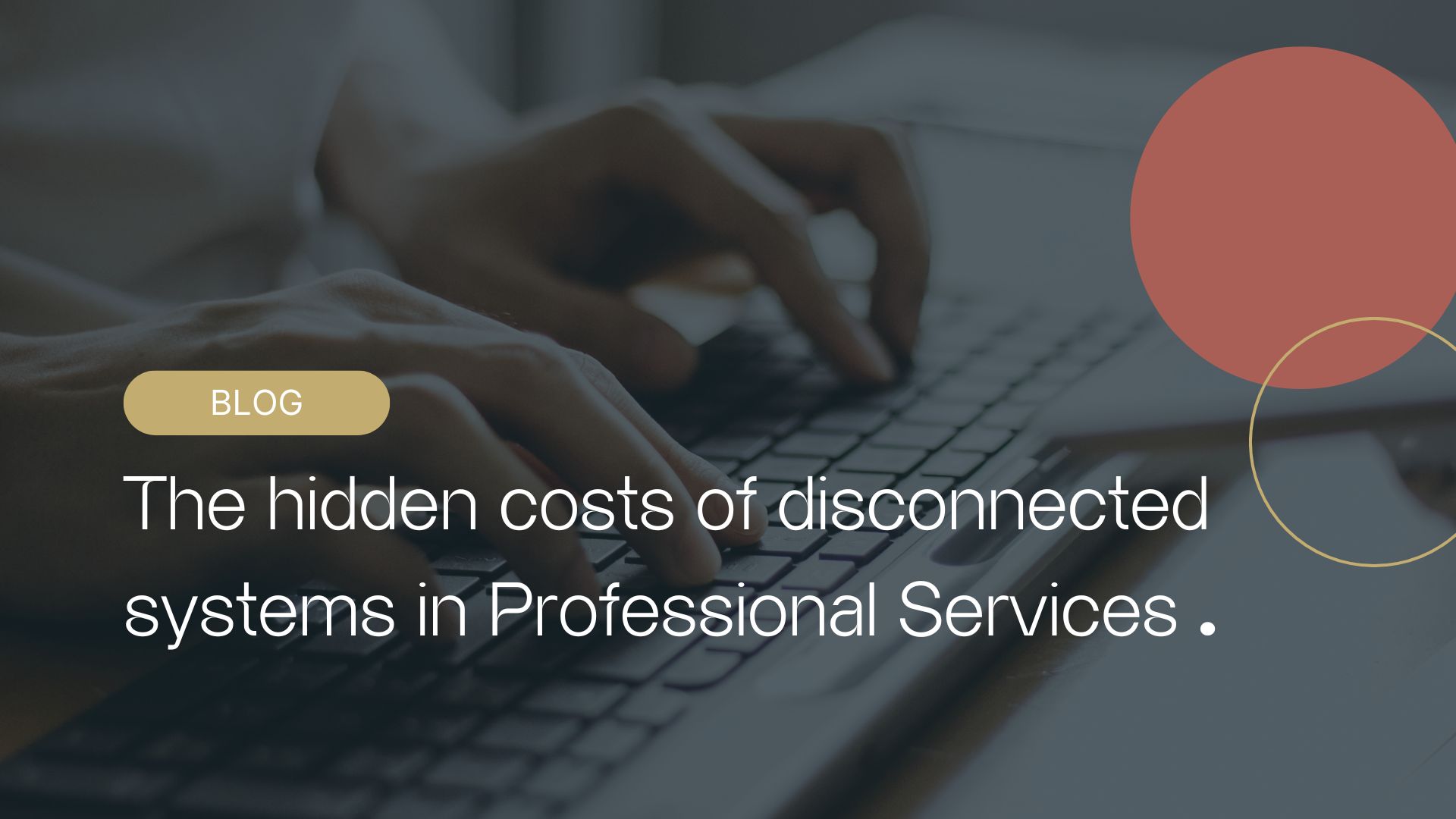
This article looks at the hidden costs of disconnected systems in professional services and why firms that want to stay competitive are turning to integrated ERP solutions.
The hidden costs of disconnected systems in Professional Services
Professional services firms, whether consulting, accountancy, legal or, for example, engineering, rely on accuracy, efficiency and collaboration. Projects are complex, clients expect transparency and every billable hour counts. Yet behind the scenes many firms still use disconnected systems: one for project management, another for time tracking, a third for billing and several spreadsheets to fill the gaps.
On the surface this seems to work. Teams get things done. But underneath the cracks start to show. The data doesn’t add up, reports take too long to produce, and decisions are made on out-of-date information. These inefficiencies may not be obvious day by day, but they add up fast, quietly eating into profit margins and slowing growth.
This article looks at the hidden costs of disconnected systems in professional services and why firms that want to stay competitive are turning to integrated ERP solutions.
The illusion of efficiency
Many organisations adopt separate tools as they grow. The logic seems sound: find the “best tool” for each task. A good project management app here, a billing platform there… all quick fixes for specific needs. But over time these systems create silos.
Because the tools don’t talk to each other staff end up spending hours transferring data manually, checking figures and trying to reconcile inconsistent records. Every time data is moved something can go wrong: a missing entry, an outdated version or a simple typing error. What started as a digital upgrade slowly turns into digital clutter.
This patchwork may look efficient, but it’s built on fragile connections. The more systems you add the slower your processes become.
Time lost to manual work
Time is the most valuable currency in professional services. When your team spends hours re-entering data or chasing information that’s time not spent serving clients.
Take a usual example: consultants log hours on one platform, managers approve them elsewhere and finance staff later copy them into a billing system. Each handover is manual, repetitive and error prone.
Even if each task only takes a few minutes across hundreds of projects and staff the cost quickly adds up. In a mid-sized firm that could mean hundreds of hours lost each month; hours that could be billed or used to focus on strategic work.
Manual processes don’t just waste time, they also wear people down. Staff who feel trapped in administrative work lose motivation, especially when they know technology could make life easier.
Hidden errors that damage trust
Disconnected systems lead to mistakes. A simple data mismatch can have big consequences: an invoice sent with the wrong amount, a report based on old figures, or a missed project milestone because one system wasn’t updated in time.
Clients see these errors. Even small ones make a professional company look unreliable. Internally, mistakes lead to pointing fingers between departments: finance blames operations, operations blame IT, and leadership can’t see the truth.
Once trust in the data is broken, every number must be double checked. The firm becomes cautious and slow. Decision making drifts from proactive management to crisis control.
Limited visibility and delayed insight
Modern firms need real time visibility. The ability to see project progress, utilisation rates and financial performance in an instant. But when systems are disconnected, that visibility disappears.
Finance teams close the books monthly; project updates happen weekly and resource data lives elsewhere. By the time reports are compiled, they’re already out of date. Leaders are steering the business using last month’s information.
Without clear insight, firms can’t see which projects are slipping, which clients are most profitable or where to allocate staff. Opportunities to act early are missed and by the time problems surface it’s often too late to fix them without extra cost.

Poor resource planning
Professional services firms live or die by how they use their people. Effective resource planning means matching the right skills to the right project at the right time. But that’s impossible when data is spread across separate tools.
If availability data isn’t up to date, one project manager might book a consultant who’s already committed elsewhere. Another employee might sit idle because nobody knows they’re free. Both outcomes waste money, either through overwork and overtime or through underutilisation.
In a connected system, utilisation and capacity data updates automatically, helping firms balance workloads, reduce stress and maximise billable hours. In disconnected setups, that visibility just isn’t there.
Compliance and audit risks
Firms are under increasing pressure to comply with data protection, accounting and audit standards. When financial and project data is split across different systems, maintaining accurate records becomes much harder. During an audit staff have to gather data from multiple places and prove it’s all there. That takes time and increases the chance of errors. Missing records, mismatched entries or incomplete histories can cause compliance headaches, and in some industries, fines.
A connected system makes compliance easier. It creates a single source of truth where every transaction and project action is trackable, reducing the stress and risk of audits.
The true cost of “cheap” systems
Many firms don’t invest in integrated software because the current mix of tools looks cheaper on paper. But when you add up the hidden costs (multiple licenses, integration fees, maintenance and manual effort) the picture changes.
Each standalone tool needs to be supported, updated and linked to the others. When one system changes its pricing or API the whole structure can break. IT teams spend time maintaining connections instead of improving business processes.
These costs don’t show up on one line on the balance sheet, but they eat into margins year after year. An integrated ERP system reduces duplication, simplifies support and provides a solid foundation for growth.
Slow, reactive decision making
Leaders in professional services companies need to act fast. Whether it’s re-allocating staff, adjusting pricing or taking on a new project, speed matters. But disconnected systems slow everything down.
If it takes days to get project profitability or resource usage figures together, decisions are made on guesswork. By the time the data arrives the situation has often moved on.
A connected data environment lets leaders see exactly what’s happening (project by project, client by client) in real time. That turns management from reactive firefighting into proactive performance control.
Employee frustration and turnover
Disconnected systems don’t just hurt performance, they hurt morale. Employees waste time switching between tools, searching for information and chasing updates. It’s tiring and demotivating, especially for younger staff who expect technology to work seamlessly.
Over time frustration builds. People start to leave, taking valuable experience with them. Recruitment and training costs are rising. Meanwhile clients notice when staff turnover increases and continuity slips.
An integrated system reduces that friction. With all data in one place processes run smoothly, people work with confidence and teams can focus on client value not internal admin.
Missed opportunities for growth
Disconnected systems make it hard to plan. Without reliable centralised data firms struggle to analyse trends or forecast accurately. Which clients bring the best margins? Which services are growing fast? Which projects consistently run over budget?
When answers to these questions depend on spreadsheets or manual reporting, strategic decisions are delayed or based on incomplete information. That limits growth. Integrated systems give you a clear view of business performance. They show you where the profits come from, where the costs rise and where investment will bring the biggest return. In short, they give you the confidence to grow with control.

The real impact: margin erosion
All these issues mentioned above (lost time, manual work, delayed insight and low utilization) add up to one thing: margin erosion. Professional services firms work on tight margins so even small inefficiencies can have a big impact.
For example, a consultancy with €10m in annual revenue could lose 3-5% of billable time to administrative inefficiencies. That’s €300,000-€500,000 gone every year – not counting rework, integration costs or missed opportunities.
An integrated ERP system doesn’t just remove those inefficiencies; it transforms how the organisation operates, making it leaner, faster, and more profitable.
Why business delays and why that’s risky
Many professional services companies know their systems are fragmented but won’t act. Reasons include:
- Fear of disrupting day-to-day operations
- Cost or implementation time
- We’ve always done it this way
But waiting only gets worse. The longer an organization relies on disconnected systems, the more complex the data landscape becomes. Each new tool adds another integration, another point of failure, another manual workaround.
Modern ERP platforms can be introduced gradually, with cloud-based deployment reducing disruption and upfront costs. The real risk today isn’t modernizing; it’s standing still while competitors move ahead.
From fragmentation to integration
Moving from a mess of tools to an integrated ERP system doesn’t have to be overwhelming. Successful implementations follow a structured approach:
1. Map your processes. Where are you wasting time and money?
2. Prioritise your pain points. Focus first on finance, projects, and people’s data.
3. Choose a platform for services. ERP solutions vary. Pick one that understands project-based business.
4. Engage your teams early. Show them how integration removes admin and improves visibility.
5. Think long-term. View ERP as a strategic foundation, not a one-off fix.
With planning and leadership, the move from disconnected tools to a unified platform delivers value in months.
Unit4 ERP
For professional services organisations ready to break free from fragmented systems, Unit4 ERP is the solution. Built for people-centered organisations, it connects projects, finance, HR and planning in one place.
Unlike generic ERP systems, Unit4 is designed for how service firms actually work: project-based, client-focused, people-driven. It gives real-time visibility into performance, automates repetitive tasks and helps teams make faster, data-driven decisions.
Firms using Unit4 ERP see better utilisation rates, higher profitability and happier employees. Most importantly they move from reactive to proactive management.
Disconnected systems drain time, money and energy from professional services firms; often without anyone realising. What looks like a working setup hides inefficiencies that eat into margins and limit growth. Remove hidden costs by connecting people, projects and finance. For clarity and control try Unit4 ERP.



